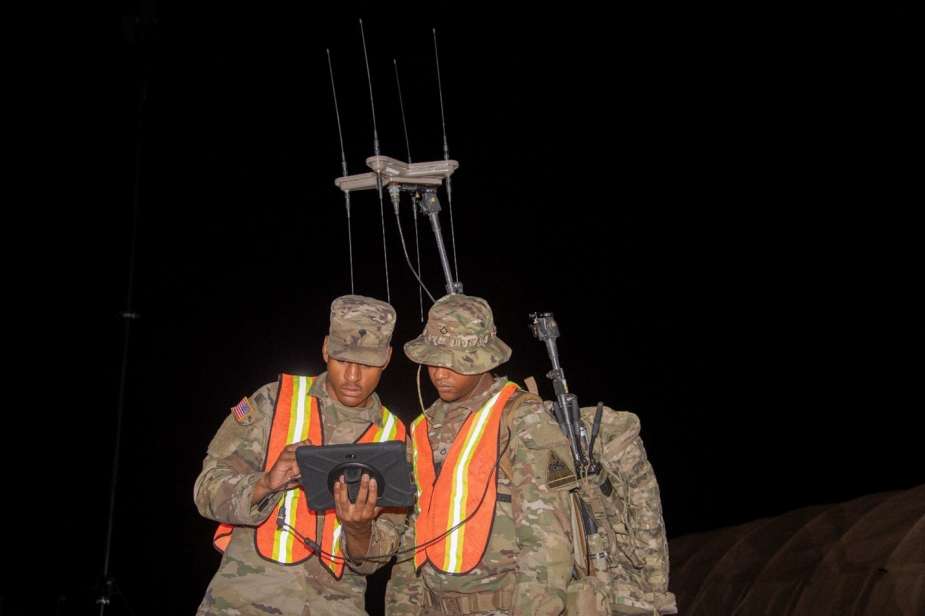Breaking news
US Army's 5th annual PNT assessment tests new tech in challenging environments.
In pursuit of its continuous transformation initiative, the U.S. Army recently convened a collaborative gathering of joint, multinational, and industry partners to explore emerging technologies within a challenging and degraded environment. Madeline Winkler, from the Assured Positioning, Navigation, and Timing Space Cross-Functional Team, provides the report.
Follow Army Recognition on Google News at this link

US Army conducts its 5th annual Positioning, Navigation and Timing Assessment to experiment with emerging technologies in denied and degraded environments (Picture source: U.S. Amy)
Taking place in August at the White Sands Missile Range, the 5th annual PNT Assessment Experiment, also known as PNTAX, served as a platform for participants to assess novel tools and systems while aligning their understanding of how future warfighters can effectively operate in environments where standard GPS and communication functions may be limited.
PNTAX is an integral component of the Army Futures Command’s ongoing campaign of persistent experimentation and continuous learning. This experiment offers participants the opportunity to field-test a range of space-based, terrestrial, aerial, and ground technologies, analyzing their effectiveness and interoperability. This, in turn, empowers the Army and its collaborators to enhance kinetic and non-kinetic targeting, as well as Soldier mobility, lethality, and survivability.
According to Mike Monteleone, director of the Army Futures Command Assured Positioning, Navigation, and Timing/Space Cross-Functional Team (APNT/Space CFT), which hosted the event, "Experiments like PNTAX provide a valuable opportunity for Soldier touchpoints that directly influence requirements. This is an environment where we can learn as an enterprise, ensuring we can build resilience and situational awareness of the battlespace. With situational awareness of the battlespace, we can more confidently build force survivability and lethality."
PNTAX serves as an early, immersive experimentation ground, enabling the Army and its collaborators to place technology, regardless of its readiness level, directly into the hands of Soldiers. These early opportunities for direct end-user feedback, often referred to as Soldier touchpoints, play a crucial role in shaping technology development and capability requirements.
In the most recent iteration of PNTAX, soldiers from various divisions had the chance to engage in Soldier touchpoints. For instance, the 101st Airborne Division participated in terrain walks and provided feedback on the Dismounted Assured Positioning System, while receiving training from partners at the Program Manager for Positioning, Navigation, and Timing.
Furthermore, soldiers from the 1st Armored Division conducted their own training exercises in a simulated threat environment. They encountered customizable, threat-based scenarios with GPS limitations and degradation, allowing them to engage in realistic tactical situations resembling a multi-domain operating environment.
Soldiers from the 10th Mountain Division collaborated with the CFT’s sensor-to-shooter team within a denied environment to understand its impact on the tactical architecture's connectivity. Meanwhile, the 2nd Infantry Division facilitated various ground maneuvers to support operations throughout the experiment.
Warrant Officer Andrew Farnsworth, an electronic warfare technician from the 1st Armored Division, emphasized the unique training opportunities offered by PNTAX: "This is training I can't recreate at my home station. The waveforms in this environment provide a unique opportunity for Soldiers to test and integrate capabilities in a denied and degraded environment."

Soldiers from the 1st Armored Division conducted their own training exercises in a simulated threat environment. They encountered customizable, threat-based scenarios with GPS limitations and degradation (Picture source: U.S. Amy)
Connecting with joint, industry and multinational partners
This year’s PNTAX hosted a variety of participants. Government, industry and academic partners converged on the range with their technology in tow, seeking to test advanced abilities in a challenging environment. Partners were encouraged to experiment with their technology, at any readiness level, to understand its strengths and limits. This approach allows for continuous improvement, a greater understanding of the environment and ultimately, better equipment in Soldiers’ hands.
Allied partners from Canada and Australia joined to observe and scope future participation, while partners from the United Kingdom conducted land navigation experiments with their Soldiers. Multinational participants worked alongside their participating Soldiers and U.S. Soldiers to replicate what operations will likely look like in future, combined force settings.
Partners are welcome to participate in the experiment with any relevant technology, as long as they agree to share data and lessons learned following the event. This exchange of information allows the Army to continue developing relevant scenarios for experimentation and advancement.
Navigating in contested environments
The open-air denied, degraded, intermittent and limited environment at PNTAX was achieved through jamming and a variety of other threat interfaces that resembled real-world, layered approaches Soldiers might face in a multi-domain operating environment. Because of the unique environments the team can create within the electromagnetic spectrum, the team is able to address a multitude of learning objectives.
“So much of our soldiers’ mission and safety hinges on their ability to effectively operate in contested environments,” said Andy Hotaling, integration director of the APNT/Space CFT. “Events like PNTAX give the Army and its partners the opportunity to ensure the technology they may see in the future can perform in these operationally focused, intelligence-informed environments.”
What’s next?
“We have a lot of valuable data to interpret following our experiment,” Monteleone said. “This data is a crucial stepping stone that informs a variety of Army needs.”
He added that the Army intends to expand opportunities for allied partners, increase the number of Soldier training activities and broaden the scope of electromagnetic spectrum experimentation for participants during next year’s event.
Next year’s experiment is already in the early planning phase alongside our partners within the U.S. Air Force’s 746th Test Squadron and the Joint Navigation Warfare Center, U.S. Army Combat Capabilities Development Command and the Army Test and Evaluation Command.
Defense News October 2023


























